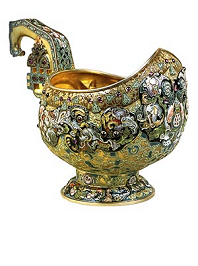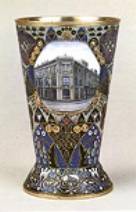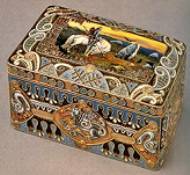Статьи и публикации
A single colour, opaque enamel decoration also distinguishes silver objects made in the Moscow workshops. Sometimes enamel covers the entire surface as a background to repousse folk motifs, such as birds on either side of the tree of life.54 Repousse designs of big, blousy tulips and other flowers found in the seventeenth-century northern enamels from Solvyche-godsk also appear.35 At other times the enamel was used as a border decoration, with enamel squares alternating with silver ones, for example.26 On occasion, small river pearls were affixed over a matte background of dark wine, medium blue, or dark green (cat. 216). The soft glow of the pearls against the flat matte colour, highlighted by the shiny silver, creates an elegant effect. Some of these, such as the kovsh in cat. 216, have stylised birds and animals enclosed in their handles in a manner reminiscent of some of the Scythian gold ornaments.
Faberge also produced silver boxes with miniature paintings on the tops. Feodor Ruckert could have supplied the artwork, although there is no evidence to date that he did37. These boxes are not to be confused with those in filigree enamel that Riickert supplied to Faberge. Made of silver and simply decorated with semiprecious stones to imitate ancient caskets, they sometimes bear Neo-Classical ornament. One such box with Empire swans along the sides has a miniature painting that depicts the defeat of Napoleon, obviously made for the one hundredth anniversary of that event in 1912. The miniature is signed 'C. Berth', about whom, unfortunately, nothing is known.
Copies of the Viktor Vasnetsov illustrations in The Prophecy of OIeg, a special edition of the tale of that name, were used on several of these boxes. Of interest is one signed 'A. Borozdin38 for Aleksandr Borozdin (born 1880), who worked for a time in the icon workshop of Vasilii Pavlovich Gulianov, a source of icons for Faberge. In fact, an icon m the Pratt collection at the Virginia Museum of Fine Arts is also signed by Borozdin.40 A year later, another box was undoubtedly made to commemorate three hundredth anniversary of Romanov rule. It is in the shape seventeeth-centure larets. or casket, and is studded with semiprecious stones.41 The miniature painting on the top is a copy of Konstantin Makovski's Choosing of the Bride, painted in 1886.42 It depicts an historical event in 1647, when Tsar Aleksei Mikhailovich ordered all the beautiful maidens of the realm be brought before him so he could choose one for his bride. These and other miniature paintings used by Riickert reflected the 'Boyarmania' that started in the 1880s -Vasnetsov and Makovski both painted their most imporant works before 1900 - and reached a fevered pitch at the time of the Tercentenary. Preferred paintings were romantic depic-tions of the bogatyrs of Kievan Russian and the life of the sixteenth- and seventeenth-century boyars, with their elabor-ate dress and richly ornamented palaces.
The master of miniature paintings on enamel was Feodor Ivanovich Ruckert, who supplied Faberge with most of his enamels in the Russian style. Ruckert's association with Faberge can be dated from 1887, when the Moscow workshop opened, to 1912, when a cup was produced to celebrate his twenty-five years with Faberge (cat. 219). Ruckert made many pieces for Ovchinnikov and Kurliukov in the 1890s and in the early years of the twentieth century, and later for Marshuk in Kiev, but what he did precisely for Faberge before 1903 is not clear. Very few pieces exhibit his early style of flowers, birds and animals in pastel colours, with Faberge overstamping his mark or with the Faberge mark alone. Most of his work for Faberge appears after 1908.
A bratina, clearly in Ruckert's style, was presenited by Nicholas II to the French admiral Germinet in 1902. It is surprise because the colours and style of the piece were not used. by Ruckert until slightly later. This could mean Ruckert was experimenting with a darker palette quite early. (These kinds of determinations can be made by matching INVENTORY numbers. After doing so, colour and style changes then become quite obvious.)
Most of the pieces made for Faberge are in the Neo-Russian style. Ruckert's son, Pavel Friedrikhovich (born 1883) entered the Stroganov School in 1899.44 If he completed the full course, usually six yearsrhe would have returned to work for his father around 1905. This could account for the design changes that are in his work just before the mark changes in 1908. The kovsh (cat. 220) presented to Ludwig Olsen, Director Nobel Factory, by his employees in 1908 is a good example.
Copies of the Viktor Vasnetsov illustrations in The Prophecy of OIeg, a special edition of the tale of that name, were used on several of these boxes. Of interest is one signed 'A. Borozdin38 for Aleksandr Borozdin (born 1880), who worked for a time in the icon workshop of Vasilii Pavlovich Gulianov, a source of icons for Faberge. In fact, an icon m the Pratt collection at the Virginia Museum of Fine Arts is also signed by Borozdin.40 A year later, another box was undoubtedly made to commemorate three hundredth anniversary of Romanov rule. It is in the shape seventeeth-centure larets. or casket, and is studded with semiprecious stones.41 The miniature painting on the top is a copy of Konstantin Makovski's Choosing of the Bride, painted in 1886.42 It depicts an historical event in 1647, when Tsar Aleksei Mikhailovich ordered all the beautiful maidens of the realm be brought before him so he could choose one for his bride. These and other miniature paintings used by Riickert reflected the 'Boyarmania' that started in the 1880s -Vasnetsov and Makovski both painted their most imporant works before 1900 - and reached a fevered pitch at the time of the Tercentenary. Preferred paintings were romantic depic-tions of the bogatyrs of Kievan Russian and the life of the sixteenth- and seventeenth-century boyars, with their elabor-ate dress and richly ornamented palaces.
The master of miniature paintings on enamel was Feodor Ivanovich Ruckert, who supplied Faberge with most of his enamels in the Russian style. Ruckert's association with Faberge can be dated from 1887, when the Moscow workshop opened, to 1912, when a cup was produced to celebrate his twenty-five years with Faberge (cat. 219). Ruckert made many pieces for Ovchinnikov and Kurliukov in the 1890s and in the early years of the twentieth century, and later for Marshuk in Kiev, but what he did precisely for Faberge before 1903 is not clear. Very few pieces exhibit his early style of flowers, birds and animals in pastel colours, with Faberge overstamping his mark or with the Faberge mark alone. Most of his work for Faberge appears after 1908.
A bratina, clearly in Ruckert's style, was presenited by Nicholas II to the French admiral Germinet in 1902. It is surprise because the colours and style of the piece were not used. by Ruckert until slightly later. This could mean Ruckert was experimenting with a darker palette quite early. (These kinds of determinations can be made by matching INVENTORY numbers. After doing so, colour and style changes then become quite obvious.)
Most of the pieces made for Faberge are in the Neo-Russian style. Ruckert's son, Pavel Friedrikhovich (born 1883) entered the Stroganov School in 1899.44 If he completed the full course, usually six yearsrhe would have returned to work for his father around 1905. This could account for the design changes that are in his work just before the mark changes in 1908. The kovsh (cat. 220) presented to Ludwig Olsen, Director Nobel Factory, by his employees in 1908 is a good example.


cat.219

cat. 217
cat. 220
Ruckert used the strong black colouring in his enamels for a brief period around 1907.
By 1908, Ruckert not only employed a palette of dark blues, greens, greys and browns, but he had also developed intricate wirework patterns. Filigree wires no longer separate colours but begin to form patterns of their own, with coils, cross ;.hatching, and rarely, as seen with one box (cat. 214), wirework actually invading the miniature painting. In this box and in a similar one (cat. 215), the wirework is strikingly like a Gustav Klimt painting. Sometimes the geometric patterns of enamel and wire give the effect of the chip work on carved wooden implements made in the Abramtsevo carpentr-v shop (see fig. 4 for the chip work on the door).
Ruckert also began to emplov those motifs found on Abramtsevo and Talashkino wares, such as chickens, guinea hens, owls (as seen on the side pieces of a frame [fig. 2] and on a silver-and-enamel box [fig. 7]). horse handles, sunflowers, and cloud berries (fig. 2), triangular shapes like mountains compare the ornament on the sides of the table in fig. 8 to the designs at the top of the box in fig. 7). and stylised pine trees which appear as part of the borders of Ivan Bilibin's illustrations.
Ruckert united these Neo-Russian motifs with romantic paintings, combining two seemingly incompatible styles by :neans of colour, in which the enamelled colours of the box complemented the colour tones of the painting. He used highlights of white or red, such as the red feet of the swans and i he red tongue of the dragon, to pick out the sunset of Bogatyr at the Crossroads (cat. 217). The enamelwork became a frame fo ' the miniature in the manner popular for posters^ theatn programs, fairy-tale covers, and menus.41 He also designed frames. The similarity between a Ruckert frame (fig. 2) and one designed by Zinoviev at Talashkino (fig. 1) gives an idea ol the influences at work.
All the miniatures on Ruckert's pieces (and he sold mam independently and through Marshak) are copies of original paintings popular at the turn of the century. While the sourc< paintings for all known miniatures have not been identified enough have been found to substantiate this claim. Mos popular were works by Vasnetsov and Makovski. While some of the Makovski paintings are little known today, several are ii Western collections. The Boyar Wedding at Hillwood Museum Washington, D.C., and The Dressing of the Bride at the DeYoung Museum in San Francisco, California, were often featured on Ruckert boxes."
Many of the paintings are totally unknown today, and the artists long forgotten. Sergei Solomko, who won a prize at the Chicago Columbian Exposition in 189S" Klavdii Lebedev, Ivan Kuliukov (fig. 7), Mikhail Avilov, and Feodor Sychkov are not household names, even in the field of art history. They were popular painters who participated in the regular exhibitions, primarily at the Academy of Art; they were illustrators of books and posters, and their work was instantly recognisable at the time. Solomko, whose painting Evening Walk appears on a kovsh (cat. 218), served as an artist for Faberge. He decorated a fan. which was a gift from Nicholas to his sister Olga at the time of her marriage in 1901 to the Duke of Oldenburg." These artists are remembered today only on old postcards and these pieces by Feodor Ruckert.
From this brief survey it is possible to see the remarkably mil and varied production of Faberge's Moscow workshops. It ran the gamut of appealing to popular taste, following the latest trends in Neo-Russian design, and leading the Neo-Classical revival of the first decade of this century. The output of the Moscow workshops was always distinguished, as both Birbauro and Bainhridge noted, by fine craftsmanship and creative design. If the work produced in St. Petersburg represented la belle epoque. the internationalism of Russia before World War 1. that of Moscow symbolised the heart of the country, its Russian soul. along with the Western cultural layers that had been spread over it since the time of Peter the Great.
Ruckert also began to emplov those motifs found on Abramtsevo and Talashkino wares, such as chickens, guinea hens, owls (as seen on the side pieces of a frame [fig. 2] and on a silver-and-enamel box [fig. 7]). horse handles, sunflowers, and cloud berries (fig. 2), triangular shapes like mountains compare the ornament on the sides of the table in fig. 8 to the designs at the top of the box in fig. 7). and stylised pine trees which appear as part of the borders of Ivan Bilibin's illustrations.
Ruckert united these Neo-Russian motifs with romantic paintings, combining two seemingly incompatible styles by :neans of colour, in which the enamelled colours of the box complemented the colour tones of the painting. He used highlights of white or red, such as the red feet of the swans and i he red tongue of the dragon, to pick out the sunset of Bogatyr at the Crossroads (cat. 217). The enamelwork became a frame fo ' the miniature in the manner popular for posters^ theatn programs, fairy-tale covers, and menus.41 He also designed frames. The similarity between a Ruckert frame (fig. 2) and one designed by Zinoviev at Talashkino (fig. 1) gives an idea ol the influences at work.
All the miniatures on Ruckert's pieces (and he sold mam independently and through Marshak) are copies of original paintings popular at the turn of the century. While the sourc< paintings for all known miniatures have not been identified enough have been found to substantiate this claim. Mos popular were works by Vasnetsov and Makovski. While some of the Makovski paintings are little known today, several are ii Western collections. The Boyar Wedding at Hillwood Museum Washington, D.C., and The Dressing of the Bride at the DeYoung Museum in San Francisco, California, were often featured on Ruckert boxes."
Many of the paintings are totally unknown today, and the artists long forgotten. Sergei Solomko, who won a prize at the Chicago Columbian Exposition in 189S" Klavdii Lebedev, Ivan Kuliukov (fig. 7), Mikhail Avilov, and Feodor Sychkov are not household names, even in the field of art history. They were popular painters who participated in the regular exhibitions, primarily at the Academy of Art; they were illustrators of books and posters, and their work was instantly recognisable at the time. Solomko, whose painting Evening Walk appears on a kovsh (cat. 218), served as an artist for Faberge. He decorated a fan. which was a gift from Nicholas to his sister Olga at the time of her marriage in 1901 to the Duke of Oldenburg." These artists are remembered today only on old postcards and these pieces by Feodor Ruckert.
From this brief survey it is possible to see the remarkably mil and varied production of Faberge's Moscow workshops. It ran the gamut of appealing to popular taste, following the latest trends in Neo-Russian design, and leading the Neo-Classical revival of the first decade of this century. The output of the Moscow workshops was always distinguished, as both Birbauro and Bainhridge noted, by fine craftsmanship and creative design. If the work produced in St. Petersburg represented la belle epoque. the internationalism of Russia before World War 1. that of Moscow symbolised the heart of the country, its Russian soul. along with the Western cultural layers that had been spread over it since the time of Peter the Great.